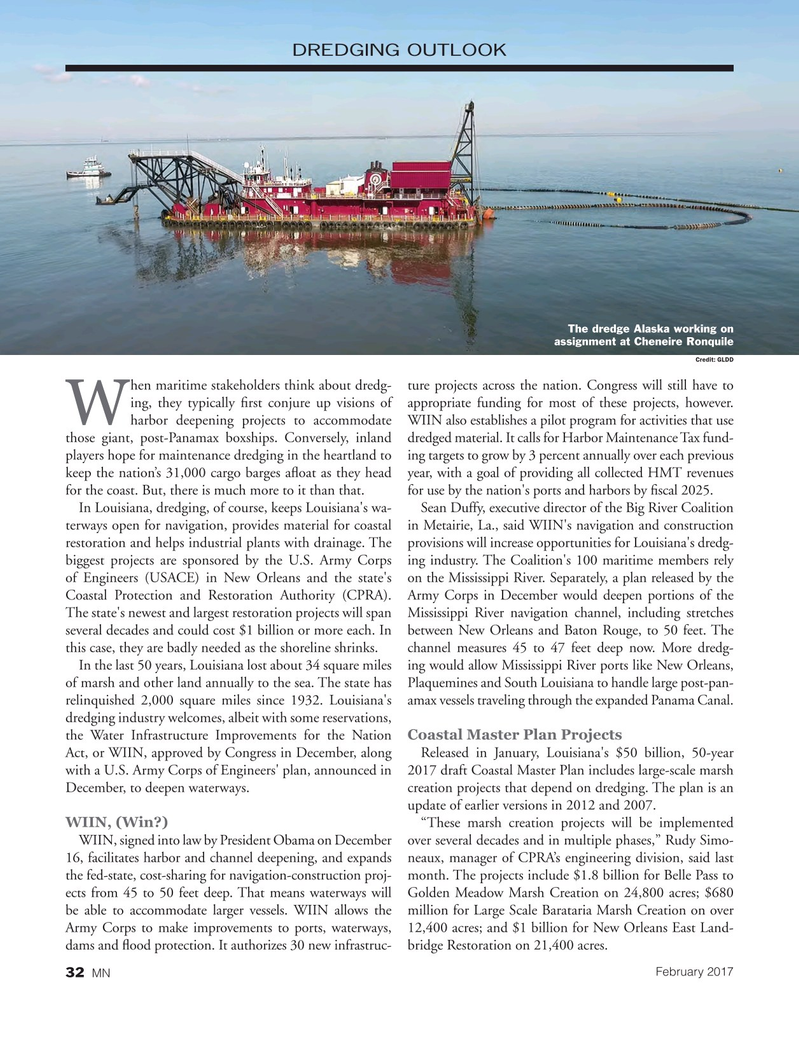
Page 32: of Marine News Magazine (February 2017)
Dredging & Marine Construction
Read this page in Pdf, Flash or Html5 edition of February 2017 Marine News Magazine
DREDGING OUTLOOK
The dredge Alaska working on assignment at Cheneire Ronquile
Credit: GLDD hen maritime stakeholders think about dredg- ture projects across the nation. Congress will still have to ing, they typically ? rst conjure up visions of appropriate funding for most of these projects, however. harbor deepening projects to accommodate WIIN also establishes a pilot program for activities that use
W those giant, post-Panamax boxships. Conversely, inland dredged material. It calls for Harbor Maintenance Tax fund- players hope for maintenance dredging in the heartland to ing targets to grow by 3 percent annually over each previous keep the nation’s 31,000 cargo barges a? oat as they head year, with a goal of providing all collected HMT revenues for the coast. But, there is much more to it than that. for use by the nation's ports and harbors by ? scal 2025.
In Louisiana, dredging, of course, keeps Louisiana's wa- Sean Duffy, executive director of the Big River Coalition terways open for navigation, provides material for coastal in Metairie, La., said WIIN's navigation and construction restoration and helps industrial plants with drainage. The provisions will increase opportunities for Louisiana's dredg- biggest projects are sponsored by the U.S. Army Corps ing industry. The Coalition's 100 maritime members rely of Engineers (USACE) in New Orleans and the state's on the Mississippi River. Separately, a plan released by the
Coastal Protection and Restoration Authority (CPRA). Army Corps in December would deepen portions of the
The state's newest and largest restoration projects will span Mississippi River navigation channel, including stretches several decades and could cost $1 billion or more each. In between New Orleans and Baton Rouge, to 50 feet. The this case, they are badly needed as the shoreline shrinks. channel measures 45 to 47 feet deep now. More dredg-
In the last 50 years, Louisiana lost about 34 square miles ing would allow Mississippi River ports like New Orleans, of marsh and other land annually to the sea. The state has Plaquemines and South Louisiana to handle large post-pan- relinquished 2,000 square miles since 1932. Louisiana's amax vessels traveling through the expanded Panama Canal. dredging industry welcomes, albeit with some reservations, the Water Infrastructure Improvements for the Nation Coastal Master Plan Projects
Act, or WIIN, approved by Congress in December, along Released in January, Louisiana's $50 billion, 50-year with a U.S. Army Corps of Engineers' plan, announced in 2017 draft Coastal Master Plan includes large-scale marsh
December, to deepen waterways. creation projects that depend on dredging. The plan is an update of earlier versions in 2012 and 2007.
WIIN, (Win?) “These marsh creation projects will be implemented
WIIN, signed into law by President Obama on December over several decades and in multiple phases,” Rudy Simo- 16, facilitates harbor and channel deepening, and expands neaux, manager of CPRA’s engineering division, said last the fed-state, cost-sharing for navigation-construction proj- month. The projects include $1.8 billion for Belle Pass to ects from 45 to 50 feet deep. That means waterways will Golden Meadow Marsh Creation on 24,800 acres; $680 be able to accommodate larger vessels. WIIN allows the million for Large Scale Barataria Marsh Creation on over
Army Corps to make improvements to ports, waterways, 12,400 acres; and $1 billion for New Orleans East Land- dams and ? ood protection. It authorizes 30 new infrastruc- bridge Restoration on 21,400 acres.
February 2017
MN 32
MN Feb17 Layout 32-49.indd 32 MN Feb17 Layout 32-49.indd 32 1/26/2017 5:17:45 PM1/26/2017 5:17:45 PM

 31
31

 33
33
